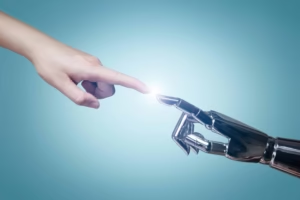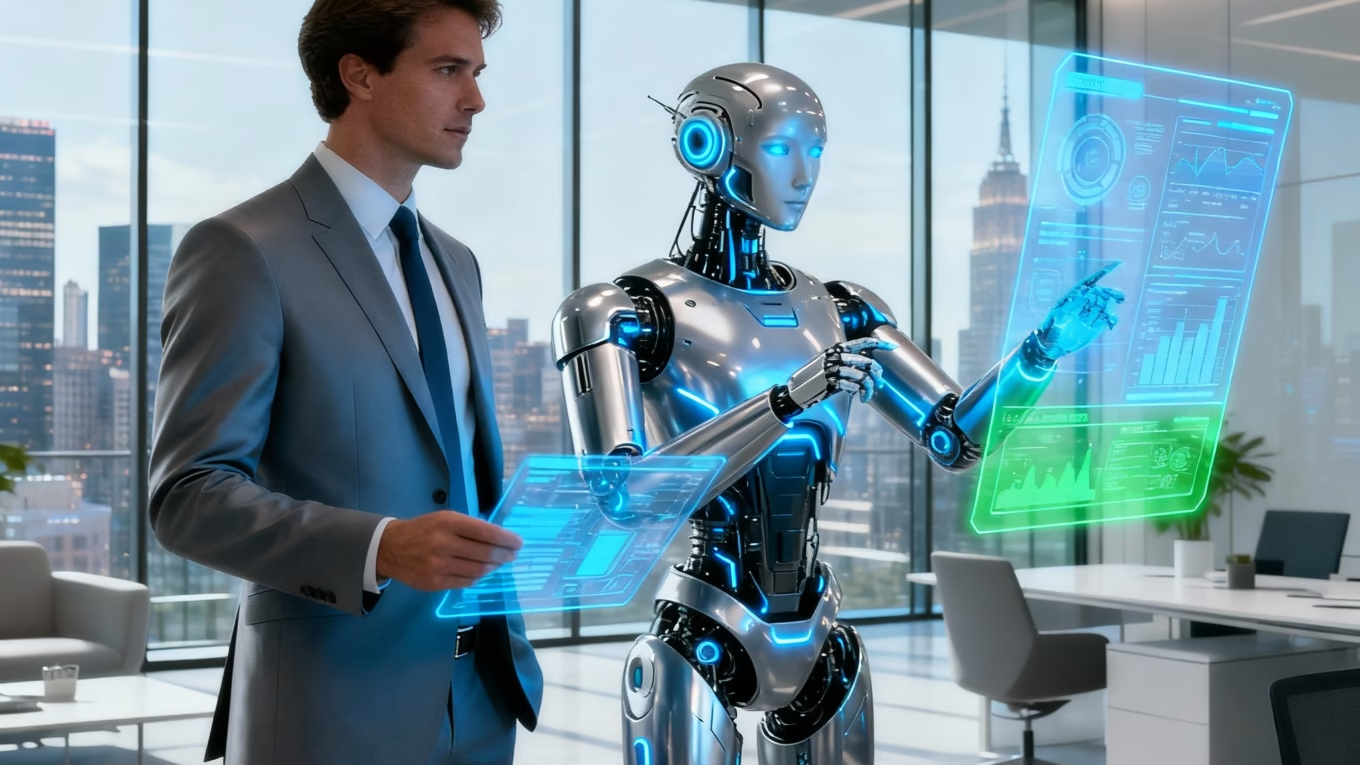The Future of Work in America: How AI and Automation Will Redefine Jobs by 2035
Introduction: The Dawn of a New Work Era

The American workplace is changing faster than at any point in history. From the first assembly lines of the industrial revolution to the digital boom of the 1990s, each era has brought new opportunities and challenges. But what we’re witnessing now is far more disruptive: the rise of artificial intelligence (AI) and automation as central forces shaping the economy.
Already, AI is answering customer service calls, self-driving trucks are completing test routes, robots are stocking shelves, and algorithms are predicting market shifts with stunning accuracy. These changes, though still early, are paving the way for a future where work itself will look entirely different.
By 2035, AI and automation will not simply replace jobs—they will redefine what it means to work in America. From the way people earn a living to how communities function, the coming decade will reshape the socio-economic fabric of the United States. This article explores where we are now, where we’re headed, and how Americans can prepare for a world where humans and intelligent machines share the workplace.
1. The State of Work in the USA Today
As of 2025, the American workforce reflects a mix of old and new dynamics:
Remote and hybrid work has become a norm since the pandemic, with millions of Americans working from home at least part-time.
The gig economy continues to grow, with platforms like Uber, DoorDash, and Upwork offering flexible income opportunities but also raising concerns about job security and benefits.
Traditional industries—such as healthcare, education, construction, and retail—still employ millions, but face pressure from automation and AI-driven innovations.
AI is no longer just a futuristic concept. Companies are already leveraging:
Customer service chatbots (think: banking apps and online retailers).
Automated warehouses, where robots pick, pack, and ship faster than humans.
AI in finance, where trading algorithms and fraud detection systems outperform manual monitoring.
This snapshot highlights a pivotal moment: America’s workforce stands on the edge of transformation, where every role—from a cashier to a corporate lawyer—could look different by 2035.
2. The Acceleration of Automation: Why 2035 Will Be a Turning Point
Why will the next decade be so disruptive? Three main factors explain why AI adoption will explode by 2035:
Exponential Technology Growth – Following Moore’s Law, computing power continues to double, enabling AI systems to process data at lightning speed.
Economic Efficiency – Businesses are drawn to automation for cost savings, precision, and scalability. Robots don’t need breaks, vacations, or health insurance.
Case Studies of Success – Amazon’s automated warehouses, Tesla’s robotic factories, and McDonald’s AI-powered ordering systems are proving that automation can significantly cut costs and boost output.
By 2035, experts predict that nearly 40–50% of current U.S. job tasks could be automated. This doesn’t necessarily mean half the jobs will vanish—but it does mean the nature of those jobs will be radically different.
3. Jobs Most at Risk from AI and Automation
Not all industries will face equal disruption. Some roles are more vulnerable than others.
Blue-Collar Roles
Trucking and delivery – With self-driving trucks gaining traction, the 3.5 million Americans working in this sector could see massive shifts.
Warehousing – Robots are already sorting, packing, and moving goods with increasing efficiency.
Construction – 3D printing and robotic machinery are beginning to handle repetitive tasks.
White-Collar Roles
Accounting and bookkeeping – AI software now handles payroll, tax filings, and financial audits.
Paralegals and legal assistants – Document review and case research are increasingly automated.
Customer service representatives – Chatbots and virtual assistants are taking over high-volume inquiries.
Retail & Service Jobs
Cashiers – Self-checkout kiosks and AI-powered scanning systems are replacing checkout lanes.
Fast food workers – AI order-taking and robotic cooking are already being piloted by major chains.
📊 McKinsey estimates that up to 73 million U.S. jobs could be disrupted by automation by 2035.
4. Jobs That Will Thrive in the AI Economy
While some jobs will decline, others will boom—often in fields where AI serves as an enabler, not a replacement.
STEM & Tech Roles
AI engineers building smarter algorithms.
Robotics technicians maintaining automated systems.
Cybersecurity experts protecting systems from digital threats.
Creative & Human-Centered Fields
Designers, marketers, and content creators leveraging AI tools to enhance creativity.
Healthcare professionals—doctors, nurses, and therapists—using AI diagnostics while maintaining the human touch.
Education specialists developing AI-driven personalized learning programs.
Green & Sustainable Jobs
Renewable energy technicians, climate scientists, and sustainability consultants will be in demand as America transitions to a greener economy.
Entrepreneurship
Automation will empower small businesses and solopreneurs to do more with fewer resources—AI will level the playing field.
5. The Rise of the Hybrid Worker
The American worker of 2035 won’t be replaced by AI—they’ll be augmented by it. This shift will create what we call the “hybrid worker.”
Examples:
Doctors using AI to analyze patient scans in seconds.
Lawyers employing AI to research thousands of cases instantly.
Teachers using AI tutors to personalize lessons for students.
The most valuable workers will be those who can combine human judgment, empathy, and creativity with AI-powered efficiency. Skills like critical thinking, adaptability, and emotional intelligence will matter more than memorizing facts.
6. Social and Economic Impacts of AI on American Life
The changes won’t just affect the workplace—they’ll ripple through society.
Wage Polarization – High-skill jobs will command higher pay, while middle-skill roles shrink.
Wealth Inequality – If unchecked, automation could widen the gap between tech-savvy elites and displaced workers.
Geographic Shifts – Automation may hit rural communities hardest, while tech hubs in cities expand.
Gig Economy 2.0 – More Americans may work independently, using AI tools to manage multiple income streams.
This transformation will challenge America’s traditional idea of the “middle class” unless policies and retraining keep pace.
7. Education and Retraining: Preparing America’s Workforce
To thrive in the AI economy, Americans must learn, unlearn, and relearn throughout their careers.
Lifelong learning will replace the “college and done” model.
Vocational training and bootcamps will focus on AI-related technical skills.
Online platforms will use AI to personalize education for each learner.
Soft skills (communication, collaboration, adaptability) will be as valuable as hard technical knowledge.
The workers who embrace continuous growth will be the ones who stay ahead.
8. Government, Policy, and the Future of Work
Policymakers will play a crucial role in ensuring the AI economy is fair and inclusive.
Universal Basic Income (UBI) – A controversial but increasingly discussed idea to support displaced workers.
Reskilling subsidies – Government and corporations may co-invest in retraining programs.
Labor protections – Ensuring gig workers and AI-augmented employees have benefits and security.
AI regulations – Balancing innovation with worker rights and privacy.
Without proactive planning, America risks leaving millions behind in the automation wave.
9. What Work Will Mean in 2035
Beyond economics, the cultural meaning of work will also shift.
Work-life blend will replace strict separation, as AI tools allow flexibility.
Americans may work fewer hours, focusing on creativity and problem-solving rather than repetitive tasks.
Work will become more about purpose, innovation, and contribution, as machines take over routine labor.
The age-old question—“What do you do?”—may have very different answers by 2035.
Conclusion: Redefining the American Dream
By 2035, AI and automation will reshape every corner of the U.S. workforce. Millions of jobs will be automated, yet new opportunities will emerge for those ready to adapt. The winners of this transition will be workers who embrace lifelong learning, businesses that balance efficiency with humanity, and policymakers who ensure inclusivity.
The future of work in America is not about choosing between humans and machines—it’s about building a future where both can thrive together.
The challenge is clear: adaptation is survival. But with the right mindset, education, and policies, America can ensure that AI doesn’t just take jobs—it helps build a stronger, fairer, and more innovative society.
